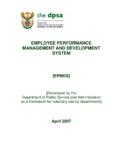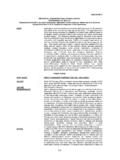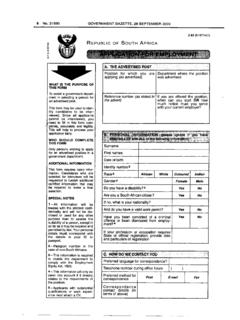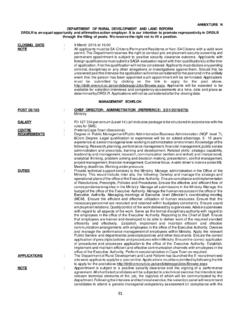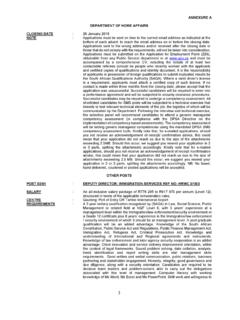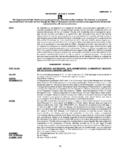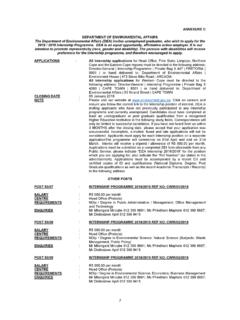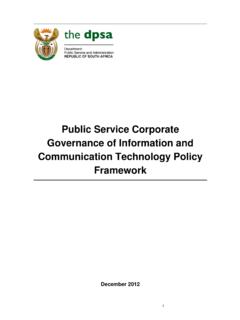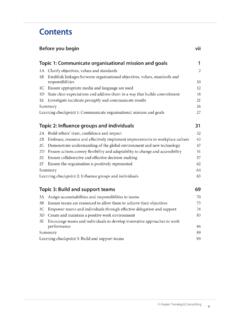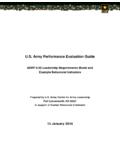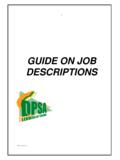Transcription of DETERMINATION AND DIRECTIVE ON THE PERFORMANCE …
1 PMDS for Employees other than Members of the SMS effective from 1 April 2018 DETERMINATION AND DIRECTIVE ON THE PERFORMANCE MANAGEMENT AND DEVELOPMENT SYSTEM OF EMPLOYEES OTHER THAN MEMBERS OF THE SENIOR MANAGEMENT SERVICE FOR IMPLEMENTATION WITH EFFECT FROM 1 APRIL 2018 PMDS for Employees other than Members of the SMS effective from 1 April 2018 Table of Contents 1. INTRODUCTION .. 1 2. AUTHORIZATION .. 1 3. SCOPE OF APPLICABILITY .. 1 4. DATE OF IMPLEMENTATION .. 1 5. COMPLIANCE .. 1 6. PERFORMANCE MANAGEMENT AND DEVELOPMENT SYSTEM FOR EMPLOYEES OTHER THAN SMS MEMBERS .. 2 7. PERFORMANCE AGREEMENT OR AN AGREEMENT OF A SIMILAR NATURE .. 2 8. PERFORMANCE MONITORING, REVIEW AND ASSESSMENT.
2 4 9. PERFORMANCE MANAGEMENT COMPLIANCE DUE DATES AND ACTIVITIES .. 5 10. PERFORMANCE MODERATION .. 5 11. COMPULSORY CAPTURING OF EMPLOYEE PERFORMANCE MANAGEMENT INFORMATION .. 7 12. PROLONGED ABSENCE DURING THE PERFORMANCE CYCLE .. 7 13. MANAGING PERFORMANCE OUTCOMES .. 7 14. MECHANISM FOR THE RESOLUTION OF PERFORMANCE MATTERS .. 8 15. ANNEXURES .. 8 Annexure A .. 8 Annexure B .. 8 CHECKLIST OF THE DETERMINATION AND DIRECTIVE WITH THE PUBLIC SERVICE REGULATIONS 2016 .. 9 1 PMDS for Employees other than Members of the SMS effective from 1 April 2018 1. INTRODUCTION Section 3 of the Public Service Act, 1994, provides that the Minister for the Public Service and Administration (MPSA) is responsible for establishing norms and standards relating to, among others, employment practices for employees which includes PERFORMANCE management.
3 The MPSA can determine these norms and standards by making regulations, determinations and directives. In terms of the Public Service Regulations, 2016 (PSR) an executive authority (EA) shall approve and implement a system for the PERFORMANCE management of employees, other than employees who are members of the Senior Management Service (SMS), and may also establish separate PERFORMANCE Management Systems for different occupational categories or levels of work in his or her department. Clause of the Public Service Co-ordinating Bargaining Council (PSCBC) Resolution 1 of 2012 (Wage Agreement for 2012/2013), provides that the employer will review the current PMDS for employees on salary levels 1 to 12.
4 The PSR has been amended to give effect to and incorporate the changes in the PERFORMANCE management for employees other than members of the SMS. Chapter 4, Part 5 of the PSR provides norms and standards on the PERFORMANCE Management and Development Systems (PMDS) for non-SMS employees which must be included in the departmental PMDS. This DETERMINATION and DIRECTIVE on PERFORMANCE management for employees other than employees who are members of the Senior Management Service (SMS) seeks to elucidate and supplement the PSR as well as to provide guidance to departments on areas requiring revision in their departmental PMDS policies. National and Provincial departments are expected to review/amend their PMDS policies and align them to the PSR and this DETERMINATION and DIRECTIVE .
5 2. AUTHORIZATION This DETERMINATION and DIRECTIVE is issued in terms of sections 3(1), 3(2) and 41(3) of the Public Service Act, 1994 read with regulations 71 and 72 of PSR. 3. SCOPE OF APPLICABILITY This DETERMINATION and DIRECTIVE is applicable to all employees, other than members of the Senior Management Services (SMS). 4. DATE OF IMPLEMENTATION This DETERMINATION and DIRECTIVE will be effective from 1 April 2018. 5. COMPLIANCE Any non-compliance with this DETERMINATION and DIRECTIVE must be dealt with in terms of section 16A of the Public Service Act. 2 PMDS for Employees other than Members of the SMS effective from 1 April 2018 6. PERFORMANCE MANAGEMENT AND DEVELOPMENT SYSTEM FOR EMPLOYEES OTHER THAN SMS MEMBERS In terms of regulation (71)(1) of the PSR, Executive Authorities (EAs) are expected to approve and implement a PMDS policy for employees other than employees who are members of the SMS.
6 The PERFORMANCE management cycle is linked to a financial year therefore, the PMDS policy should be approved by an EA prior to the PERFORMANCE cycle for which the system is to be implemented. The EA may establish separate PERFORMANCE management systems for different occupational categories or levels of work. The PMDS policy for employees other than SMS members shall hinge on the following dimensions: Key Result Areas (KRAs), describe the core functions or broad area of responsibility of an employee. It is broken down into number of outputs and activities. Generic Assessment Factors (GAFs), describe the competency requirements taking into consideration the knowledge, skills and attributes relevant to the employee s work.
7 Departments shall develop their own templates which will be used for PERFORMANCE contracting, review and assessments. An EA may use a single assessment instrument to assist in deciding on an employee s probation and PERFORMANCE . PERFORMANCE Agreements (PAs) or an agreement of similar nature must be signed by both parties ( the employee and the supervisor) for it to be valid and binding. An employee acting in a higher position shall be assessed at the level of his or her post that he or she occupied at the time immediately prior to the acting position and the awarding of PERFORMANCE incentives if he/she qualifies shall be calculated on the lower level. Any deviation from the provisions of the system during the cycle may be approved by the relevant executive authority only if such deviation is not to the detriment of any employee and is not inconsistent with the provisions of the Public Service Act, the PSR and this DETERMINATION and DIRECTIVE .
8 7. PERFORMANCE AGREEMENT OR AN AGREEMENT OF A SIMILAR NATURE The PMDS policies of departments shall provide for the employee and supervisor to enter into a PERFORMANCE agreement or an agreement of a similar nature. All employees shall conclude and sign their PERFORMANCE Agreements (PAs) or an agreement of similar nature on or before 31 May of each financial year. The relevant supervisor shall ensure that the signed PAs or agreements of similar nature are submitted to their internal Human Resource Management components on or before the end of the first working day following the due date for signing of PAs or agreement of similar nature. The EA or delegated official may include internal departmental timelines in their PMDS policies to ensure compliance with these dates.
9 Newly 3 PMDS for Employees other than Members of the SMS effective from 1 April 2018 appointed employees shall conclude, sign and file their PAs or an agreement of similar nature within three months of the date of appointment and thereafter, within two calendar months of the beginning of each financial year (Regulation 72(1) of the PSR). An employee who is appointed, seconded or transferred to another post or position at the same salary level must enter into a new PA or agreement of a similar nature for the new post or position within three calendar months of his/her appointment/secondment/transfer (Regulation 72 (2) of the PSR). For seconded employees, a copy of the signed PA or agreement of similar nature must be submitted by the seconding department to the releasing department within 30 days.
10 An employee who does not comply with the requirements in paragraphs , and above, shall not qualify for any PERFORMANCE rewards, pay progression and PERFORMANCE bonus (Regulation 72(7) of the PSR). Employees are discouraged from amending a PA or an agreement of a similar nature in the last quarter of a PERFORMANCE cycle ( 1 January to 31 March), unless changes to the employee job description, job grade, organisational structure of the department or its functions or amendments to the objectives and priorities result in significant changes to the content of the job of the employee. In the case where the amendment of the PA or an agreement of a similar nature is justified, the amended PA or agreement of a similar nature must be accompanied by a written motivation explaining the reasons for the changes.
